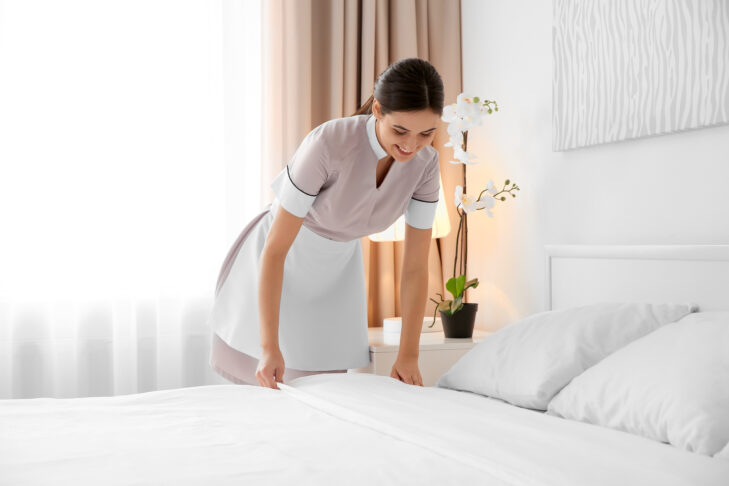Whether it’s the shiver of an overactive A/C unit or the stuffy air from a swollen filter, hotel guests know discomfort when they feel it. And they’re quick to complain when room temperatures dip too cold or heat up too hot. Maintaining ideal conditions is crucial for hotels working to keep visitors happy and ratings high.
That’s why more and more hotels are installing air pressure switches to monitor their HVAC systems. These clever devices track air pressure throughout a building, letting staff know when ventilation rates dip below set thresholds. Early notification of drops and surges allows hotel engineers to quickly adjust equipment before small issues balloon into guest-facing problems.
In this article, we’ll break down the value air pressure switches bring to the hospitality sector and outline key usage cases in hotel settings. Read on to learn how this technology takes guest comfort to the next level.
The Hotel HVAC Balancing Act
Crafting an atmosphere conducive to relaxation puts unique demands on hotel HVAC systems. Unlike homes or businesses, room usage patterns in hospitality settings tend to fluctuate wildly as guests come and go. Occupancy and activity spikes at check-in times or during conferences load HVAC equipment in bursts. Extended vacant periods then leave systems idle.
This start-stop rhythm strains HVAC machinery over time. Components wear out faster, filters clog more readily, and desired temperatures grow harder to maintain. Equipment failure is 3-4 times more likely in hotels than in other buildings as a result.
When breakdowns occur, hotels end up in reactive mode — physically checking room readings, adjusting set points by trial and error, and responding to guest complaints after they happen. This process is time-consuming, disruptive, and costly. Worst of all, it leaves visitors steaming over flawed experiences hoteliers strive to perfect.
This reactionary cycle persists because most hospitality HVAC systems lack real-time monitoring. Management simply doesn’t have the data to know which units work overtime or how filtration falters during vacant periods. Identifying small issues like stuck dampers or drifting set points before guests are impacted is near impossible.
Automatic Feedback With Air Pressure Switches
This information gap is where air pressure switches prove invaluable for hotels. Installed on air handlers and ductwork, these compact sensors track differential pressure across HVAC systems down to decimals. Pre-set parameters trigger automatic adjustments when readings sway too far in either direction.
For example, a switch monitoring a hotel air handler may have cut-in and cut-out points set at 1.0 and 1.5 inches of water pressure (IWP) respectively. If inlet pressure drops below 1.0 IWP, the switch triggers a frequency drive to increase fan speed. The motor accelerates airflow until pressure climbs back above 1.0 IWP.
Conversely, pressure above 1.5 IWP suggests ductwork filters are clogging. The drive slows airflow to avoid straining the system until readings stabilize under 1.5 IWP again. These self-regulating “set and forget” capabilities allow switches to maintain safe, steady conditions without constant human tinkering.
Common Hotel Applications
This automated handling makes air pressure switches invaluable across hotel HVAC applications. Common uses cases include:
1. Monitoring Filter Status
As mentioned above, switches installed near air handlers give excellent filtration insight. Preset thresholds provide early warning when dust and debris accumulate to problematic levels. Facility staff get notification to swap filters long before guests feel stuffy air.
Positioning additional sensors further downstream in ductwork tracks conditions room-by-room. Sudden pressure jumps in occupied suites signal blocked vents or other urgent issues needing response. Data logging allows engineers to estimate optimal filter replacement cycles as well.
2. Adjusting Ventilation Rates
Air pressure switches also help hotels balance ventilation requirements. Guidance suggests most hospitality settings maintain CO2 concentrations below 800 parts per million (ppm) through sufficient air exchange. Levels from 600-800 ppm keep guests comfortable without excessive energy waste.
Placement at duct inlet and outlet points gives pressure switches visibility into these exchange rates. Pre-determined pressure drop benchmarks aligned to target ppm levels allow switches to automatically throttle fans to maintain efficient air turnover. This helps properties comply with local ventilation codes as well.
3. Preventing Imbalanced Air Flow
Uneven airflow is another hotel HVAC headache air pressure switches alleviate. Common causes like closed vents, design flaws, or equipment issues create over-cooling or insufficient heating in parts of buildings. Guests nearest these problem zones wind up too hot or too cold as a result.
Ideally balanced HVAC distribution maintains temperatures within +/- 2 degrees of set points across all rooms simultaneously. This minimizes guest disruptions and comfort complaints. Installing air pressure monitors across zones makes achieving this consistency much simpler. Any sensor showing readings 10-15% above or below the average alerts staff to redirect resources.
Getting Set Up
With so many monitoring possibilities, where should hotels add air pressure switches first? Begin by identifying 2-3 major HVAC pain points your property wants to resolve. Common options are:
· Decreasing guest temperature complaints
· Reducing filter replacement labor
· Minimizing mechanical failures/emergency repairs
Outline how pressure monitoring can address the root causes underlying each issue. This helps determine optimal switch placement and programming parameters upfront.
Work with your HVAC provider to wire switches into control systems accordingly. Modern interfaces integrate sensor data alongside temperature, CO2, and humidity feeds. This consolidation offers hotel engineers complete climate control visibility from one dashboard.
Fine Tuning for Satisfaction
Like any technology, air pressure switches perform best when continuously optimized. Set routine checks after installation to ensure target parameters match actual occupancy patterns. As with all data streams, more sensors increase coverage and insights over time.
Expected switch lifespans of 100,000 cycles or more make the investment well worthwhile over years of reliable service. Better yet, improved guest satisfaction metrics confirm the value of maintaining properly pressured systems hotel visitors can comfortably enjoy.

